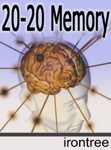 From time to time, I like to go back through sites I've visited before, and see what they have to offer now.
From time to time, I like to go back through sites I've visited before, and see what they have to offer now.
One site I first mentioned back in September 2006 that had some excellent software offerings, as well as some great planned offerings, disappeared. However, the good news is that this site, Iron Tree Software, is back in a new form as a blog! One of their original offering was 20-20 memory, an Excel file that generated random numbered lists of items to memorize. It has been reborn as a full-fledged program, and the new version of 20-20 is available as a download from Lybrary.com (Currently Windows only. Due to the nature of the program, many Wine implementations have trouble running it).
There are plenty of free goodies available from Iron Tree Software, as well. One post features an excellent lesson on the link system. Another one teaches the Substitute Word system by helping you learn 20 country names and their capitals. As a free bonus, you can quiz yourself on these countries and their capitals via iFlipr, the iPhone Flashcard program I mentioned back in July. iFlipr can also be used online with just about any browser, so you don't have to have an iPhone to try out this quiz.
Over at the StackView Musings blog, Nick Pudar has just posted an entry detailing a binary marking system for a memorized deck, using ideas from Bob Farmer and Ed Marlo. Readers of Antominy may recognize this idea from when Nick first published it in issue 8, back in 2006. The binary idea isn't for everyone, but a non-binary version is offered. Even if you never use this, the post is worth a read just for the thought that went into the development, which may help spark other ideas of your own.
In my previous post, I mentioned Ronald P. Doerfler's work, mainly concerning the Hipster PDA and his book, Dead Reckoning: Calculating Without Instruments. On his Dead Reckonings blog, he's posted a very interesting 3-part series on lightning calculators. Part 1: The Players discusses the history of these math whizzes, and their various styles. Part 2: The Methods discusses the various approaches and shortcuts used to make these feats impressive. My favorite section is Part 3: The Media, which is an excellent lesson in presentation. In this final section, you learn all about how the feats themselves get magnified by the way they're presented in the media. As the old saying goes, it's not what you do, but what they remember you doing that counts.
The final updated old favorite is one I created. The newest version of my Memory Effects PDF was posted on November 14th! As always, it's available at the previous Scribd link, or from the Downloads section in the rightmost column of this page.
0
Revisiting Old Friends
Published on Sunday, November 23, 2008 in downloads, fun, magic, math, memory, memory feats, playing cards, products, software
Related Posts
Post Details
Posted by Pi Guy on Nov 23, 2008
Labels:
downloads,
fun,
magic,
math,
memory,
memory feats,
playing cards,
products,
software
Subscribe to:
Post Comments (Atom)




No Response to "Revisiting Old Friends"
Post a Comment